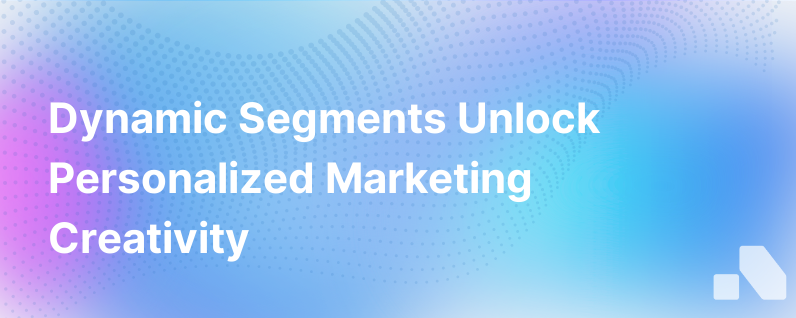
In today’s marketing landscape, the battle for consumer attention has become fiercer than ever. But in the cacophony of the digital age, one clear melody rings through the noise: the power of personalization. We've all heard the buzzword, but few understand just how transformational specificity-driven creativity can be for engagement and conversion rates.
Personalization stands as more than just an industry trend; it’s the backbone of modern marketing strategies. Smart marketing teams know that to cut through the clutter, they must deliver the right message, to the right person, at the right time. The question is, how can marketers achieve such a precise level of targeting? The answer lies in the utilization of dynamic segments.
The Mechanism Behind Dynamic Segmentation
Dynamic segmentation slices through your broader audience to create specific clusters based on real-time data and complex algorithms. These segments evolve continuously as they respond to user behavior, preferences, demographics, and a multitude of other factors, enabling marketers to craft campaigns that speak directly to a defined group of users with shared characteristics.
The Benefits of Specificity-Driven Dynamic Segmentation
- Increased Engagement: When messages resonate with a specific set of needs or interests, they generate a higher level of engagement.
- Higher Conversion Rates: Personalized campaigns are significant drivers of conversions as they present solutions that appear tailor-made for the consumer.
- Improved Customer Experience: Relevant messaging that feels personalized improves the overall customer experience, enhancing brand perception.
- Better Resource Allocation: By focusing efforts on segments that are more likely to convert, marketers use their budgets more efficiently.
Harnessing Specificity for Creative Brilliance
There’s a counterintuitive truth in creative work: limitations foster innovation. When working within the constraints of a dynamically created segment, the creative team must think deeply about the problems, desires, and behaviors of a specific group. This specificity demands and directs creativity, leading to more innovative and effective marketing strategies.
Building Marketing Campaigns on Dynamic Segments
Here's how marketers can leverage dynamic segments to fuel personalized marketing:
1. Data Collection and Integration
Collecting vast and varied datasets is step one. Utilize web analytics, CRM data, social media interactions, transaction histories, and more. The key is in the integration of this data, where AI and machine learning play pivotal roles. These technologies identify patterns and preferences on which dynamic segments are built.
2. Defining Micro-Segments
The more granular you get with your segments, the more personalized your marketing message can be. For instance, instead of targeting "women in their 30s," target "women in their 30s, interested in sustainability, with a history of purchasing organic skincare products."
3. Crafting Tailored Content
With a clear picture of a segment's traits, crafting content that resonates becomes a focused exercise in creativity. Brands can develop unique narratives that speak directly to the pain points and aspirations of that segment.
4. Multi-Channel Execution
Deploy personalized campaigns across various platforms where the defined segment is active. Be it email, social media, or web advertisements; connectivity through multiple channels strengthens the personal touch.
5. Dynamic Personalization
Utilize dynamic content that changes based on who is viewing it. Employing this layer of real-time customization elevates the sense of individual attention and relevance.
6. Continuous Learning and Optimization
As segments evolve, so should your strategy. Analyze performance metrics to refine your approaches continuously. AI-driven analytics tools can offer powerful insights for ongoing optimization.
Dynamic Segmentation in Action
Think of an online retailer that uses dynamic segmentation to identify a group of customers who have viewed but not purchased children's wear in the past fortnight. A boutique creative campaign targeting these users might involve emotional marketing focusing on the joy of parenting, juxtaposed with seasonal offers on children's wear, delivered via Facebook, email, and Pinterest, platforms known to be frequented by these users.
As this example shows, dynamic segmentation turns a blunt marketing message into a surgical strike that resonates with the audience's current mindset and needs.
Challenges and Considerations
However, leveraging dynamic segments isn't without its challenges:
- Balancing personalization with privacy concerns is critical.
- Achieving a seamless integration of data from multiple sources requires robust technology.
- Avoiding segmenting to a level where the audience size becomes too small to be impactful is a fine line to tread.
Conclusion
In the quest for personalization, specificity is not a hindrance but rather a powerful catalyst for creativity. Dynamic segments unlock the ability to create highly relevant and effective marketing campaigns. By understanding and capitalizing on the ever-changing nuances within their target market, brands can craft messages that not only reach but also resonate with their audience.
Thus, while dynamic segmentation requires a structured approach and sophisticated technology, its powerful impact on marketing creativity and campaign performance makes the journey from data collection to personalized experience a worthwhile venture. As marketers, embracing the specificity that dynamic segments offer might just be the key to unlocking new heights of customer engagement and brand loyalty.